A Look at Rainy May Days in Shin Hanga and Sosaku Hanga Prints
Most of May’s weather has been pretty cold and rainy so far, so I thought I’d look at art (which I do every day anyway) to take my mind off of it. Of course, a title including “May Rain” caught my eye, and got me contemplating yet another one of those fascinating dichotomies in art history: dueling philosophies.
This one involves the Japanese print movements that arose after the ukiyo-e style had more or less run its course during the Meiji period (1868–1912). The Westernization of Japan after it was “opened” by the US and Britain in the mid-1800s really helped to make ukiyo-e subject matter and style seem rather passé. It did not help that the official Japanese “academies” considered woodblock prints a “minor” art form compared to painting. An effort by groups of artists in the early 1900s to resurrect the spirit of ukiyo-e resulted in the shin hanga (new print, the Kawase and Tsuchiya) and sosaku hanga (creative print, the Onchi and Azechi) movements.
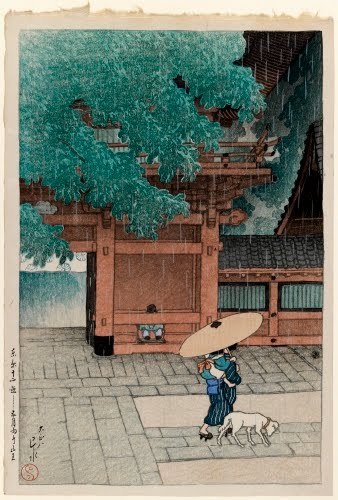 |
| Kawase Hasui (1883–1957), May Rain at Sanno, from the series Twelve Subjects of Tokyo, ca. 1920s. Color woodblock print onpaper, 11 3/8" x 10 3/8" (28.8 x 26.3 cm). © Brooklyn Museum. (BMA-2823) |
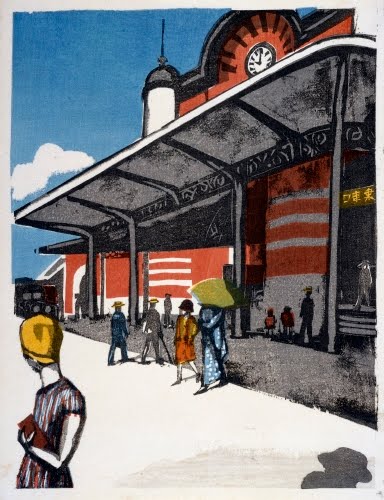 |
| Onchi Kōshirō (1891–1955), Tokyo Station, from the series Scenes of Lost Tokyo, 1931, reprinted 1946. Color woodblock print on paper, 10 1/4" x 7 7/8" (26 x 20 cm). © Worcester Art Museum. (WAM-528) |
Just a little comparison with the shin hanga print above (Kawase) and a classic Hiroshige depiction of rain. I love the vibrant colors of the classic ukiyo-e, but the Kawase has such wonderful softly contoured forms. I can’t decide which I like better!
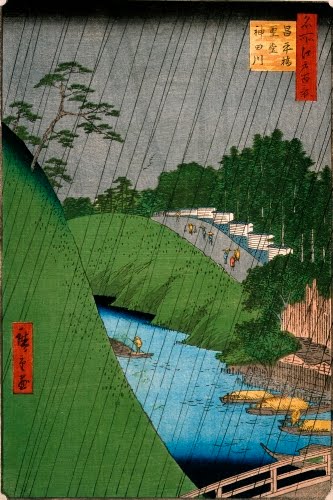 |
| Utagawa Hiroshige I (1797–1858), The Fudo Waterfall at Oji, #47 from the series One Hundred Famous Views of Edo, ca. 1857. Color woodblock print on paper, 14 3/16" x 9 7/16" (36 x 24 cm). © Worcester Art Museum. (WAM-194) |
The art form of the multiple-block woodcut print flourished in Japan during the Edo Period (1615–1868). It is primarily known in the West in the ukiyo-e style, prints that showed city life and familiar landscapes as representations of the transient physical world. The style persisted briefly after the Edo Period, particularly in landscape and cityscape prints.
Shin hanga and sosaku hanga had their origins in Japan as a reaction to the rapid industrialization of the country after its “opening” to Western powers. At the turn of the 1900s, there was a great debate in Japan in artistic and literary circles about traditions in Japanese art. This was in part influenced by the Japanese exposure to European modernism: many Japanese artists travelled to Europe during the 1890s. Another factor was the reaction by young artists during the first decade of the 1900s to stifling cultural strictures and the establishment in 1907 of the Japan Fine Arts Academy, which looked upon printmaking as a “minor art.”
Artists of these print movements were committed to rejuvenating the spirit of the ukiyo-e genre of woodblock printing in all its aspects. The artists of the shin hanga movement, which flourished between 1915 and 1947, emphasized the traditional hierarchy of artist, woodblock carver, and publisher as separate entities in the process of producing prints. This was in contrast to the sosaku hanga (creative print) artists who made sketches, drew the design, cut the woodblock and printed it themselves. Sosaku hanga evolved as an idea in the 1890s, and is sometimes assigned the “starting date” of 1904 with publication of creative prints in Myojo magazine. Sosaku hanga as a genre flourishes to the present day and the is sometimes referred to as “New Hanga.”
Both print movements reflected Western influence in style. Ironically, both shin hanga and sosaku hanga prints had more appeal abroad than in Japan.
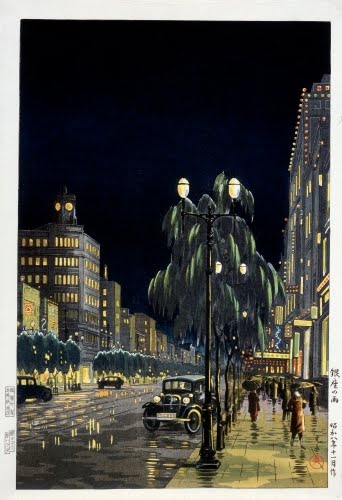 |
| Tsuchiya Kōitsu (1870–1949), Rain in Ginza, from the series Tokyo Views, 1933. Color woodblock print on paper, 12 15/16" x 17 3/8" (32.9 x 44 cm). Worcester Art Museum. (WAM-531) |
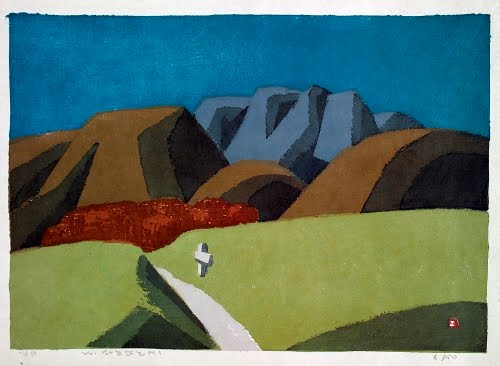 |
| Azechi Umetaro (1902–1999), Sunlit Plateau, 1940. Color woodblock print on paper, 15 1/2" x 10 13/16" (39.5 x 27.5 cm). © Worcester Art Museum. (WAM-669) |
Correlations to Davis programs: Explorations in Art Grade 1: 4.21; Explorations in Art Grade 2: 1.studio5-6; Explorations in Art Grade 4: 1.studio3-4, 1.Meet Ando Hiroshige; Explorations in Art Grade 6: 2.7, 2.8; A Community Connection: 4.5, 8.2; A Global Pursuit 7.5; Experience Printmaking: 3, 4; Exploring Visual Design: 5; The Visual Experience: 3.5, 9.4, 13.5; Discovering Art History: 2.2, 4.4


Comments